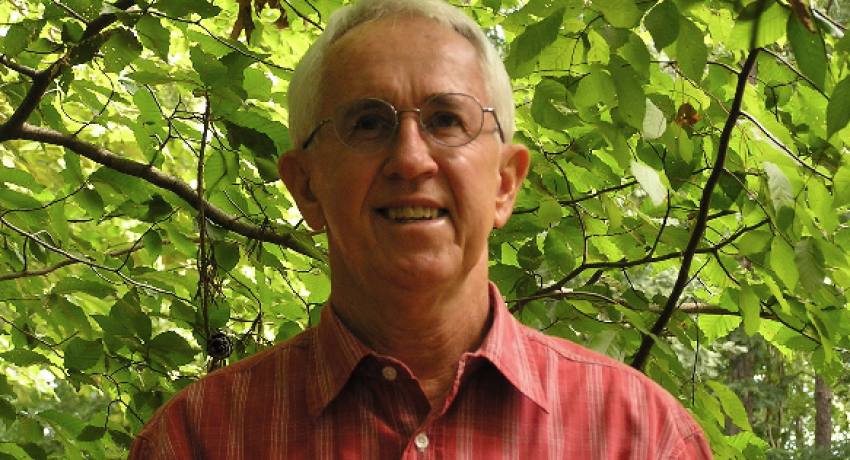Russ Messier
By Jamie Oberdick
UNIVERSITY PARK, Pa. — Faculty, staff and students from across Penn State and especially in the College of Engineering and Materials Research Institute (MRI) are mourning the loss of Russ Messier, graduate alumnus and professor emeritus of engineering science and mechanics, who died on Oct. 11 at age 80 in Nashua, New Hampshire.
“When Russ came to Penn State, he began a more than 50-year career as a materials scientist who was a significant figure and pioneer in the realm of thin-films research, and materials research in general,” said Clive Randall, Evan Pugh University Professor of Materials Science and Engineering and director of the Materials Research Institute. “His work was instrumental in developing the fundamental understanding of morphological evolution with the thin film sputtering technique, developing chiral structures or sculpture thin films with sputtering, and researching diamond and boron nitride deposition leading to an international center on diamond films.”
Born in Nashua on July 30, 1944, Messier’s passion for science and engineering vied with his passion for golf. From an early age, he was an avid golfer; starting as a caddy for the Nashua Country Club at the age of 10, shooting in the mid-70s as a teenager and winning the league golf championship as part of the Alvirne High School team. A strong all-around athlete, he also co-captained his high school’s soccer team and was known as a dancing star at the school’s Friday night dances.
But it was the Sputnik Era that sparked his love of science and drove him to win scholarships and earn money at a variety of jobs to enable him to attend Northeastern University in Boston, where he graduated with a bachelor's degree in electrical engineering in 1967. During this time, he served in an engineering co-op program at Sanders Associates, an electronics company now part of BAE, an aerospace, defense and information security company. It was here where Messier discovered a love for materials science.
This led Messier to Penn State, where he earned a doctoral degree in solid state science in 1973, completing his graduate research as part of the Materials Research Laboratory (MRL), which was merged into MRI in 2001. Celebrated Penn State researcher Rustum Roy, then the director of MRL, was his thesis adviser.
Along with his research work, he was president of the Graduate Student Association (GSA) and became interested in social justice, including working to foster understanding between student protestors and University administration during the Vietnam War and civil rights movement. In fact, it was during his GSA protest activities that he met his future wife, Linda. They were married in 1969 and had two children, Steve, born in 1970, and Tammy, born in 1974, whom they raised in State College.
After receiving his doctoral degree, Messier went on to work at GTE-Sylvania for two and a half years before returning to Penn State to join the faculty. His early work focused on thin film morphology, which describes surface structure and how an arrangement of a very thin layer of material affects behavior or performance in various applications, such as in electronics or coatings.
Perhaps the pinnacle of Messier’s research career at Penn State and MRL was his discovery of how to grow diamond-like thin films. He often joked that he should grow Linda a diamond ring or necklace, but the significance of this breakthrough reached beyond jewelry. Diamond-like thin films offer extreme hardness, durability and chemical resistance, making them valuable for protecting surfaces and enhancing the performance of tools, electronics and medical devices. His success led to his photo being featured on the front page of the Sunday edition of the New York Times on Sept. 14, 1986 as well as in USA Today on March 18, 1987.
As the founding editor-in-chief of the international journal Diamond and Related Materials, Messier was a leader in his field. He started an international consortium on diamond-like materials, bringing together experts from academia and industry. Over his career, he supervised 28 graduate students, mentored numerous faculty members and was a role model for countless undergraduate students. In 2005, after being named a Highly Cited Researcher in Materials Science — placing him in the top 0.5% of citations in his field — he retired as a full professor and was granted emeritus status. He also held the position of acting director of the MRL in 1992.
Messier retired to Clarksville, Virginia, to enjoy golf and a local lake. However, he quickly became involved in the community; mentoring the first robotics team of the local high school, the Backpack Buddies program which provides bags of food for the weekend to food insecure students and several other community projects.
A service will be held on Saturday, Nov. 23, at 2 p.m. at Clarksville Presbyterian Church, with the Rev. Annette Eckerd Goard officiating. In lieu of flowers, the family requests those who are interested consider a donation in Russ Messier’s memory to one of the following: The Russell Messier Memorial Scholarship at Alvirne High School; Dunkirk Camp and Conference Center; or Backpack Buddies, Clarksville Presbyterian Church.

